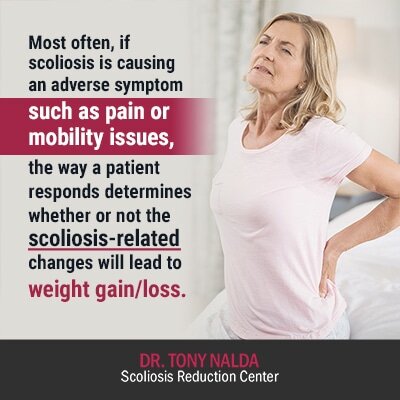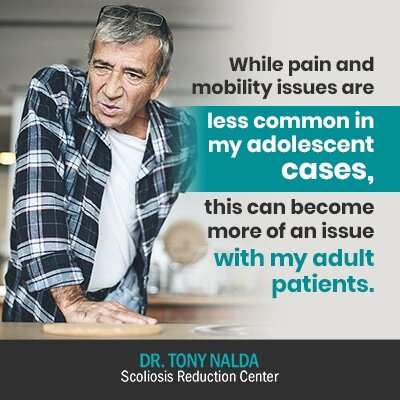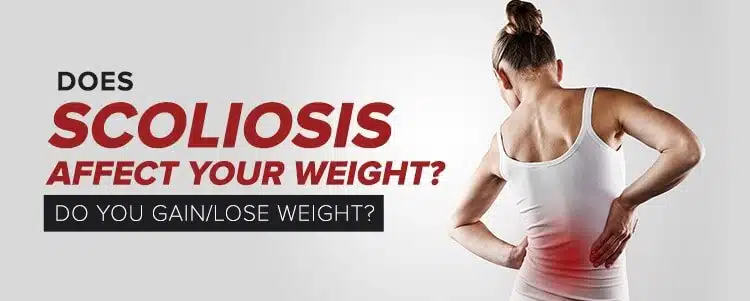While some studies do show a connection between low body mass index and the onset of adolescent idiopathic scoliosis, I believe the general connection between scoliosis and weight gain/loss is most accurately described as ‘indirect’. Based on a patient’s age and the severity of their condition, scoliosis can cause some adverse health effects that can indirectly affect weight gain/loss by how the patient responds. For example, if a patient’s scoliosis is causing them pain, and the patient responds by eliminating exercise, this can lead to weight gain; however, this is more of an indirect connection as the pain is the scoliosis-related symptom, and the resultant inactivity is how the patient is responding to it.
Despite the fact that scoliosis has been around for hundreds of years, it is still somewhat of a mysterious condition. For example, in the condition’s most common form, adolescent idiopathic scoliosis (AIS), we don’t fully understand why it initially develops. We are still exploring a multitude of variables that could be connected to scoliosis development, and weight is one of those variables. Before we look at how direct/indirect the connection between scoliosis and weight gain/loss can be, let’s take a look at the connections that some studies have found between weight and scoliosis onset.
4 Key Takeaways
- Indirect Connection Between Scoliosis and Weight: The relationship between scoliosis and weight gain/loss is largely indirect, influenced by how patients respond to scoliosis-related symptoms, such as pain and mobility issues, rather than the condition itself directly causing weight changes.
- Low BMI and Scoliosis Onset: Studies indicate a correlation between low body mass index (BMI) and the development of adolescent idiopathic scoliosis (AIS), suggesting underweight individuals may have a higher risk of developing scoliosis due to reduced muscle mass and bone density affecting the musculoskeletal system.
- Scoliosis as a Multifactorial Condition: Scoliosis, especially AIS, is considered multifactorial with no single known cause. While weight may play a role in its development, it represents just one of many factors that could contribute to the condition’s onset.
- Importance of Active Lifestyle and Treatment: An active lifestyle and engaging in a functional treatment approach can mitigate indirect weight-related issues caused by scoliosis. Staying active and maintaining a healthy weight can enhance treatment effectiveness, improve flexibility, and support overall spine health.
Here’s a video you can watch to learn more:
What Some Studies Indicate: Low Weight and Scoliosis Onset
Traditionally, a lot of focus on the relationship between medical conditions/diseases and weight are centered around obesity, as it is so prevalent and known to produce a myriad of adverse health effects.
When it comes to scoliosis, however, studies have found a correlation between low body mass index (BMI) and the development of scoliosis in adolescents; BMI is a body-fat measurement based on height and weight.
In one Korean study, the increasing onset of scoliosis amongst elementary school-aged children was explored in terms of its connection to body composition: weight, height, and spine structure.
What the study found was that children classified as ‘underweight’, or ‘severely underweight’, had a significantly higher incidence of developing scoliosis. The study results indicated that having a lower BMI results in less muscle mass, which then adversely affects the musculoskeletal system and increases the risk of scoliosis onset.
Based on this study’s findings, there is a strong correlation between low weight and scoliosis development. Low weight also affects bone density, and the combined effects of a reduction in bone density and an unstable musculoskeletal system can increase the likelihood of scoliosis development.
While this study doesn’t really address the question of how/if living with scoliosis can affect weight gain/loss, which we will get to later, it does show a connection between weight and scoliosis development.
Does Scoliosis Cause Low Body Weight, or Vice Versa?
In another study, the relationship between altered body composition present before the onset of clinically-detectable scoliosis is explored. This study was different in how they determined ‘altered body composition’ by including both fat and lean mass as components of body weight.
The study also addressed the connection between leptin deficiency in adolescents with scoliosis: important because it’s the body’s fat cells that secrete leptin. Leptin is a hormone whose main role is to regulate fat storage and calorie consumption.
This study addressed the question of whether scoliosis causes adolescents to become underweight, or whether their underweight status prior to the onset of scoliosis is a contributing factor to its development. The findings suggested that scoliosis does not induce low body weight in adolescents, but rather is the other way around; low body weight increases risk factors for scoliosis.
The above studies establish a connection between weight, musculoskeletal health, bone density, hormone levels, and the onset of clinically-detectable AIS.
Scoliosis is Multifactorial
While the correlations found by the aforementioned studies are positive in terms of gaining a better understanding of the overall condition and possible prevention, I have to be clear that in the condition’s most common form (AIS), there is no one single known cause; its causation is, instead, thought to be ‘multifactorial’. This means that idiopathic scoliosis is thought to develop in adolescents because of a combination of multiple factors, and these factors can vary from person to person.
In this regard, you can see how correlations found between the onset of adolescent idiopathic scoliosis and variables such as weight, as promising as they are, could just be giving us one piece of a very large and complex puzzle.
Now, let’s move on to exploring how weight can be affected in a person living with scoliosis, and if the relationship between scoliosis and weight gain/loss is best described as ‘direct’, or ‘indirect’.
Living with Scoliosis and Weight Management
So we have established that there could be a correlation between weight and the onset of scoliosis, but once a person has scoliosis and is adjusting to daily life with the condition, just what role does scoliosis play in weight management?

As we know that scoliosis is progressive and incurable, a person diagnosed with scoliosis will be living with it throughout their lives. Understanding how to respond to symptoms in a healthy and scoliosis-friendly way is important.
As mentioned earlier, I consider the relationship between weight gain/loss and scoliosis is best described as ‘indirect’. Most often, if scoliosis is causing an adverse symptom such as pain or mobility issues, the way a patient responds determines whether or not the scoliosis-related changes will lead to weight gain/loss.
Scoliosis-Related Pain and Mobility Issues
As scoliosis develops across a wide severity spectrum as mild, moderate, or severe, one person’s experience living with the condition can be completely different from the next.
Also, multiple factors such as age, overall health, and the chosen treatment approach also play significant roles in how the condition affects a person’s daily life.
Does scoliosis itself directly cause my patients to gain or lose significant amounts of weight: no. Can scoliosis cause residual effects that can be responded to in ways that can lead to weight gain/loss: yes.
Indirect Connections Between Scoliosis Symptoms and Weight Gain/Loss
For my adolescent idiopathic scoliosis patients, pain is not a common part of their experience. In addition, it doesn’t generally cause functional deficits in mild and moderate forms. Even some cases of severe scoliosis don’t produce a lot of noticeable functional changes.
So in many of my AIS patients, neither pain nor significant mobility issues, are a huge factor, especially for those with milder forms, who are in good shape, and are engaging in active treatment; for those who might not be in great shape, have a severe form, are experiencing pain/mobility issues and are not getting treatment, how they respond is key to weight management.
If a person is in good shape and leads an active lifestyle prior to being diagnosed with scoliosis, this doesn’t have to change once they learn they have scoliosis. While some adjustments might need to be made to account for scoliosis-friendly activities and limit those that exacerbate symptoms, there are correlations between those who stay active and better treatment success.
As it’s much easier to see the spine of a person who is at a healthy weight, this makes diagnosing and monitoring the condition much easier. In addition, a healthy weight equals a healthier body, enabling them to better handle any scoliosis-related challenges or intense treatment regimes.
Spinal rigidity is a big problem for people with scoliosis. As a condition progresses, the spine loses more and more of its flexibility. The more rigid a person’s spine is, the more work has to be done to try and restore some of the spine’s flexibility at the onset of treatment.
People who are active, whether they have scoliosis or not, tend to be more flexible. Movement keeps the muscles loose and engaged, and this means they are better able to fulfill their roles, such as the muscles that support and stabilize the spine.
The very design of the spine and its healthy curves is to facilitate movement. A spine that doesn’t engage in regular movement is going to become stiff and result in a loss of surrounding muscle mass. If the muscles that support the spine become weak due to lack of movement, they are less able to support and stabilize the spine throughout treatment and beyond.
If an adolescent patient has a severe form and is overweight going into the condition, they are more likely to experience pain and/or mobility issues; how they respond to these challenges is key. We would need to tweak their treatment plan to address these issues to ensure they could carry on with their scoliosis-specific exercise regime and therapy.

If the patient decided to avoid exercise and physical activity because it caused them discomfort, this could result in weight gain; on the flip side of that, if a patient who started treatment overweight decided to fully embrace the healthy changes and exercise regime needed to minimize scoliosis symptoms and work towards a reduction, they could end up losing weight, and this would likely make treatment easier and more effective.
While pain and mobility issues are less common in my adolescent cases, this can become more of an issue with my adult patients.
Adult Scoliosis, Pain, and Mobility Issues
As mentioned earlier, adolescents experience life with scoliosis a lot differently than adults. As adults have already reached skeletal maturity, their spines become vulnerable to the compressive force of an abnormal spinal curvature, and this can cause intense back, neck, and radiating nerve pain into the arms, legs, and feet.
This can be particularly true in cases of adult degenerative scoliosis, where their scoliosis has developed as a result of degenerative changes to the spine and its intervertebral discs. This form is also most common in adults over the age of 40, who tend to be less active generally.
Anyone who has struggled with chronic pain due to spinal degeneration will understand how challenging it can make maintaining a healthy and active lifestyle. Obviously, the pain and resultant mobility issues can make a person less active, and this can result in residual weight gain.
Treating adult scoliosis involves working towards a curvature reduction that takes them back to where they were prior to the onset of disruptive symptoms. As we produce a structural change by reducing the curvature, related pain and mobility issues are lessened along the way.
In severe forms of adult and adolescent scoliosis where the patient is experiencing additional complications such as lung impairment, this can also make exercising difficult as it can interfere with the patient’s ability to inhale and exhale deeply. In these types of cases, exercise will need to be adjusted in intensity and duration.
Again, it’s how a patient responds to the changes that scoliosis can produce that determines whether they will gain or lose weight as a result of their condition, rather than weight gain/loss being considered a common symptom of scoliosis.
Conclusion
The connection between scoliosis and weight gain/loss is an interesting one. As is the case with many other questions surrounding the condition, there are no simple cut-and-dry answers.
While studies about weight and scoliosis seem to focus on how it can affect causation and onset, in terms of living with scoliosis, the connection between weight gain/loss and scoliosis is more indirect.
As scoliosis ranges so greatly in severity, what might produce certain physical changes in one patient can produce the opposite in another. When it comes to adolescents and adults with scoliosis, I feel the latter is the age group most likely to face the indirect complication of weight gain.
The more severe a condition is, the more likely it is to produce noticeable symptoms such as postural changes, pain, and related mobility issues. Depending on just how severe these symptoms are and the patient’s response, they can lead to residual weight gain or loss.
The chosen treatment approach will also factor into this. If a patient opts for an active functional treatment approach, they will be engaging in a scoliosis-specific treatment plan that will include exercise, therapy, rehabilitation, and chiropractic. If a patient opts for a passive traditional approach, a huge portion of treatment involves passively observing the condition, and not engaging in active efforts to lessen symptoms, maintain mobility, and reduce the curve. A functional treatment approach is far more effective at keeping a patient mobile, active, and potential weight gain at bay.
The same can be said of another scenario; if a patient is overweight and in poor physical shape prior to starting treatment, they could decide to embrace exercise as a healthy way to deal with any scoliosis-related pain and mobility issues they might experience. This choice can produce the residual effect of weight loss, enabling the patient to better handle the rigors of treatment, increase chances of treatment success, and live their best life with the condition.





